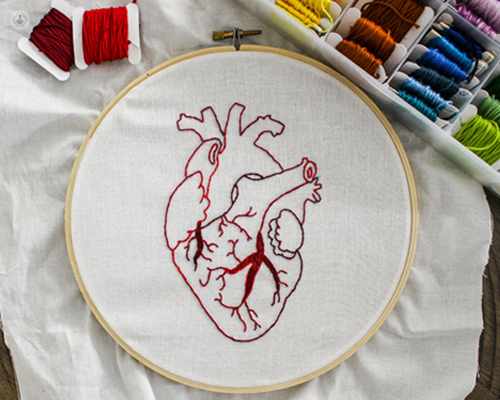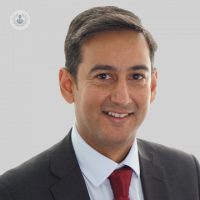Aortic surgery: when is it necessary?
Written by:All arteries that supply the body with oxygen-rich blood originate from the aorta, the body’s main blood vessel. Esteemed consultant vascular surgeon Mr Paritosh Sharma shares his expertise on when surgery may be required to treat the aorta. The London-based surgeon explains who could be suitable for surgery and gives an insight into what recovery looks like.

What is aortic surgery?
The aorta is the main blood vessel in the body, which carries blood from the heart all around the body, supplying the organs and limbs with oxygen. Aortic surgery may be carried out for two main reasons. The first is the narrowing of the aorta. If you imagine the aorta like a hose pipe taking blood from the heart to different parts of the body, if a narrowing occurs in the main blood vessel, it can restrict the blood flow to the target organs. Sometimes patients can have trouble walking because there isn’t enough blood getting to their legs and the muscles are starved of oxygen.
Another reason why aortic surgery may be necessary is aneurysms, which is the swelling or bulging of the weakened walls of the artery itself. An artery can only swell to a certain point before it bursts. If the aorta was to burst, it could be a fatal event so to prevent that, sometimes patients will have open surgery or endovascular surgery in the form of stents to repair the aorta.
When is aortic surgery necessary?
If surgery is being considered for narrowed walls of the artery, then it would depend on the severity of the patient’s symptoms. Indications that surgery is required would be the inability to walk even very short distances, insomnia caused by extreme pain in the feet at night, or difficulty carrying out the minimum activity. Patients presenting with ulcers or non-healing wounds on the legs may require surgery as well.
For aneurysms, there are set guidelines that are followed. For example, if the patient has an aneurysm in the infrarenal part of the aorta, part of the aorta between branches to the kidneys and where it divides to supply the legs, if the aorta’s maximum size is 5.5 centimetres, surgery would be recommended. Surgery on other parts of the aorta, such as the thoracic aorta in the chest, would be carried out in compliance with the size guidelines.
Who is a suitable candidate for aortic surgery?
It is difficult to give a concrete answer as to who is suitable for surgical intervention as it depends on their symptoms and the distribution of the disease. The main factor that affects suitability for surgery is the patient’s physiological condition, simply put how fit and well they are. A balance has to be struck between the risks of big surgery and the benefits we would hope to achieve. For instance, the risks for someone who is unable to walk very long distances and whose only option is an open operation, differ from the risks for a person who is suitable for a small stent operation or angioplasty.
Patients will be assessed by how far they can walk, whether they experience pain at night, and whether they have ulcers. Imaging would be performed, such as MRI, CT scans, or arterial duplex ultrasounds, to determine the degree of narrowing. With all this information, it can be decided what the best way forward is.
When considering surgical treatment for aneurysms, it really depends on how big it is and whether the patient is fit enough to undergo the procedure. The risks really have to be assessed properly to determine whether it would be the right thing for the patient or not.
How long does aorta surgery take?
The answer really depends on the type of surgery. A big open aneurysm repair can take anywhere upwards of two hours, depending on how technically easy or difficult the operation is. A straightforward stent operation for an aneurysm can take an hour or two. For a bespoke stent, the time required would depend on the technical difficulty, perhaps a bit longer.
For narrowing, if it is a stent operation it may be a bit quicker, but it varies a bit depending on what the exact procedure is.
How long does it take to recover from aortic surgery?
Again, it depends on the type of surgery. If a stent graft is used to treat an aneurysm in the abdomen the patient will usually go home a day or two after surgery, whereas with a bespoke stent the patient may need a few days longer.
If larger, open aortic repair, which involves the branches of the aorta that supply the abdominal organs, is performed, the patient may be in hospital for a longer time. If we are dealing with the aorta below this, then the average hospital stay for a patient is 5 days. After such major operations, it will take a while for patients to return to their normal activities, anywhere from six weeks to three months to feel back to their normal selves. During this recovery period, patients shouldn't lift heavy things, for example, to avoid disrupting the closure of the abdominal wall and the muscles that have been put back together following surgery.
Can you live a normal life after aortic surgery?
A patient can absolutely live a normal life following aortic surgery, I know this from patients I have operated on. That being said, patients do need to understand that it is a big operation and the body will need time to heal and recover fully.
If you are interested in booking a consultation with Mr Paritosh Sharma, you can do so directly on his Top Doctor’s profile.


